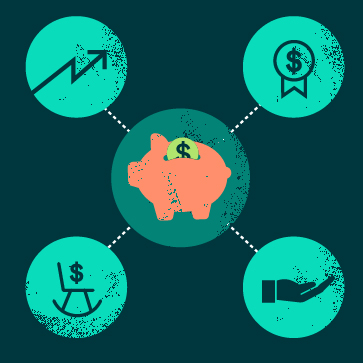How to Start Investing With Just $5
October 12, 2021 • 18 minute read
How to Start Investing With Just Five Dollars
The idea of investing can be intimidating; people often think it requires a great deal of research, time and money to get started. Fortunately, an initial investment may require just a small amount of research time and a minimal amount of money. Thanks to the magic of compound interest, investing as little as $5 may grow into a healthy amount of savings over time.
The first step in investing — researching investment vehicles and finding the right fit — is perhaps the most daunting. However, once you begin learning about your options, you’ll probably be surprised to find it’s less demanding than you think. And a small investment can go a long way, especially if you start early.

Is it worth it to start investing with a small amount of money?
Before addressing how to begin investing, you may be asking: Is investing just $5 even worth considering? The answer is a resounding “yes”!
Beginning with a small investment is a great way to learn the ins and outs of investing and to get your initial investment started. Even if you don’t immediately gain hundreds of dollars from your first investment, you may gain valuable insights and knowledge into various investing tools. Starting small may also help you determine which investment vehicles you prefer.
For example, some people prefer a more hands-off approach, as is typically the case with a classic 401(k) employer-sponsored retirement account, a traditional individual retirement account (IRA) or a Roth IRA. One convenience of a 401(k) is that contributions are typically automatically deducted from your paycheck, making it easy to regularly contribute to your account. Many financial advisers recommend depositing your funds automatically because you’re less likely to miss money that was never in your bank account to begin with.
Alternatively, some people enjoy watching their funds grow through some of the newer investment apps like Stash or Robinhood, while other people prefer more complex and volatile investment vehicles like Bitcoin and other cryptocurrencies.
Regardless of how you choose to get started, a small initial investment is also a good way to minimize risk while you’re still learning.
When is the right time to start investing?
Investing at a young age is the best way to take advantage of compound interest even if you don’t have much money to invest. Compound interest has often been called “the eighth wonder of the world” because it makes it possible to earn money on your interest, which essentially means that your money may grow exponentially over time. However, your money needs to reside in an investment vehicle to take advantage of compound interest. It’s recommended that you start early because time is compound interest’s best friend.
Consider this example: Imagine you put $200 in an investment account every month for 10 years, and it earns a 6% average return. After 10 years, the account would have grown to $33,300. Of that amount, you would have invested only $24,200. This means you would have earned $9,100 just by letting your money sit in your account earning interest. Compounding earnings may really add up, given a healthy amount of time.
What are your goals for investing?
Investment strategies are highly individualized — everyone has different goals and expectations when setting aside money for investing. For example, if you’d like to be hands-on with your investments, your preferred investment tool may look very different compared with someone who wants to set up their investments and then leave them alone.
For some people, it’s important to invest in individual companies they’re passionate about. For others, investing in companies with a lot of growth potential is a priority. Your individual timeline for investing may play a major role, as well. For example, if you have 30 to 40 years to invest, your strategy will likely be very different compared with someone who only wants to invest for the next five years. For these reasons, it’s a good idea to consider your main goals for investing before deciding on your investment vehicles.

Understanding your investment options
When you’re getting started with investing, you may want to begin by first learning about your investment options. Different investment vehicles have advantages and disadvantages that you should consider before you squirrel away your hard-earned money in them. Here are some of the main types of investment vehicles you may want to consider:
Stocks
A stock (also known as an equity) is a share of ownership in one company. A share of a company’s stock provides the shareholder with a small ownership interest in the company. It’s also possible to receive dividends with an individual stock, depending on the type of stock. A dividend is a distribution of a portion of a company's earnings, generally paid to shareholders.
Of course, growth is not guaranteed with stocks; individual stocks may be risky if the company does not perform well. If this is the case, the value of its stock may drop. Conversely, when a company is doing well, the value of its stock typically rises. Stock prices may also vary widely, with costs ranging from just pennies to thousands of dollars per share.
Bonds
Bonds are a loan to a company, organization or governmental entity. Unlike stocks, they do not provide any ownership interest. Instead, the agreement with the entity is that you’ll purchase the bond, and the bond will provide a guaranteed return over a certain number of years.
Bonds usually pose less risk for investors when compared with stocks. However, the rate of return on a bond is generally lower than most stocks.
Mutual funds
A mutual fund is a mix of investments that are packaged and sold together. Professional investors put funds together for their clients so clients don’t have to spend the time and effort selecting individual stocks and bonds. Mutual funds often have a theme, such as a general industry, or they may be reflective of the market as a whole.
For example, index funds are a type of mutual fund. These funds are designed to attempt to closely follow a particular market, and they are usually not professionally managed. This lack of management may make them more cost-effective because there are either lower management fees or no fees.
Retirement funds: 401(k)s and IRAs
Although retirement funds are usually discussed separately from investment vehicles such as stocks, bonds and mutual funds, they often have some overlap. For example, a 401(k) that is sponsored by an employer may contain mutual funds.
If you invest in a retirement fund, you are usually investing in one or more mutual funds. A third party generally manages these funds, and your level of input or activity will vary, depending on your specific type of 401(k).
Top 5 ways to start investing with just $5
Today, it’s easier than ever to get started with investing. Even just a few years ago, it usually required a modest sum of money to make an initial investment. Now, however, you may begin with just a few dollars. Here are five ways to get started with as little as $5:
1. Online brokerage accounts
An online brokerage account is an account in which you deposit money with a licensed brokerage firm, and the firm places trades on your behalf. Although the broker executes the orders, the assets in the account belong to the investor. Online brokerage accounts often offer free transactions or charge a limited fee for each transaction, particularly for exchange-traded funds (ETFs). However, online brokerage accounts may have maintenance fees or service fees that you should consider before using a particular service.
Many popular investing apps are just an extension of an online broker, but there are plenty of well-known online brokers to choose from. Online brokerage accounts may allow you to set up automatic deposits to your investment account, which may help you grow your investment over time.
2. Direct participation programs
Direct participation programs (DPPs) involve purchasing stocks directly from a company, just as the name implies. You generally don’t need to use a brokerage account to purchase the stocks, and there usually is no intermediary involved; purchasers may go directly to the source.
DPPs may be a great way to invest in individual companies. They may also provide some or all of the following benefits:

- You typically don’t have to pay broker commission charges.
- You may be able to purchase fractions of shares (which you generally cannot do when using a traditional broker).
- You may directly support an individual company that you believe will do well, either immediately or over time.
However, DPPs have some drawbacks as well. Specifically, they may be tough to find. Companies usually do not directly promote their DPPs, so you may have to do some research to find them. Also, the process for getting started with this type of investment often varies by company, therefore it may be a bit confusing to figure out how to get started. Additionally, not every company offers a DPP, so options may be limited.
3. Investing apps
If you’ve already been considering investing, chances are good that you’ve heard of a number of popular investing apps. These apps attempt to make investing easy and streamlined, and some even provide resources to help you learn more about investing.
Every app is different, but some allow you to purchase portions of stocks, which may enable you to start investing with smaller amounts of money. This is a great way to dip your toe into the investing world without taking on a lot of risk. However, some investing apps may require a minimum investment, while others have no limitations.
Bear in mind that investing apps vary a great deal in terms of what types of investments they offer. Some investing apps allow you to select from only a few predetermined portfolios, while others allow you to invest in individual stocks. Also note that investing apps may charge a fee for transactions or a fee for opening an account.
Taking time to research and compare investing apps is the best way to find the right app for your situation.
4. Exchange-traded funds (ETFs)
An ETF, or exchange-traded fund, is a bundle of securities that you can purchase through a brokerage firm. They are generally traded on an exchange like a stock, but they typically have lower fees than other types of funds.
Although an ETF typically operates similarly to a traditional mutual fund, it’s usually possible to invest a smaller amount of money in an ETF than a mutual fund.
Common types of ETFs include:
- Market ETFs: Market ETFs are designed to track an entire market, such as the S&P 500 or NASDAQ. These are sometimes called index ETFs, and if the market goes up or down, the ETF typically moves up or down in line with that market.
- Bond ETFs: Bond ETFs include a full range of available bonds, including U.S. Treasury Department bonds, corporate bonds, municipal bonds and more.
- Sector ETFs: Sector ETFs hold various stocks from companies in the same sector, such as technology, pharmaceuticals or oil.
One of the appeals of ETFs is that they provide immediate diversification, and you may make your initial investment without needing to research individual companies.
Another advantage of ETFs is that they generally trade like stocks. They have their own ticker symbol and share price, and they can be purchased through most brokers and sometimes through online brokers. Although it’s usually possible to buy just a few shares, partial shares are generally unavailable for purchase.
An ETF often requires a trading commission fee. These fees vary from about $4.50 to $11, depending on the broker and the ETF involved. However, if you purchase an ETF and hold it for a period of time and the ETF increases in value, the minimal fees may prove to be worth the investment.
5. Fund companies with low minimums
A fund company is an investment company that invests pooled money from many investors, allowing them to make larger investments as a group. They may also develop and hold mutual funds.

Fund companies generally require a higher initial investment compared to other investment vehicles. However, one advantage of using a fund company is that a financial professional is typically managing your investments. Vanguard, Charles Schwab and Fidelity are examples of fund companies.
In many cases, you may need to start with an IRA at some fund companies before you can take advantage of their lower minimum initial investment mutual funds. Even if you only contribute a small amount of money to an IRA, starting as soon as possible is the best way to get the biggest bang for your buck, thanks to the power of compound interest.
Take advantage of employer-provided retirement accounts
One of the best ways to get started with investing is to ensure you’re taking full advantage of your employer’s 401(k) program if they offer one. Many employers offer a matching contribution program to encourage employee participation.
For example, some employers throughout Washington state will match employee contribution percentage by percentage. For example, if an employee deposits 3% of their income into their 401(k) plan, the employer deposits the same amount of money into the employee’s plan. Employees who participate in this type of program are essentially giving themselves a 3% raise via their employer’s 3% contribution. Keep in mind, however, that the amount of employer-matching contribution varies if it’s offered at all.
Getting more information about investment options
Although making your first investment may sound like an intimidating process, you may be happy to learn it doesn’t have to be a time-consuming process. And your upfront investment may be as low as a few dollars. Learning about the different investment vehicles available may help dispel any myths or misconceptions and may shed light on the right investment strategy for you. Whatever your situation, be sure to get the right information before making this important financial decision.
Not sure where to start when it comes to managing your money?
Not sure where to start when it comes to managing your money?
Get answers, not judgment. WSECU offers pro advice to help you grow your financial future.
